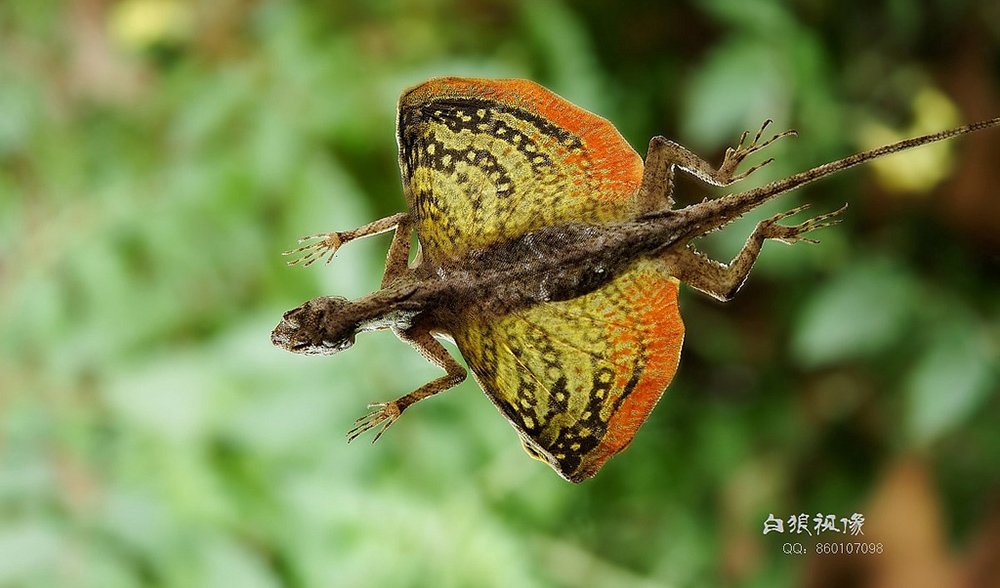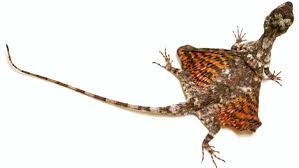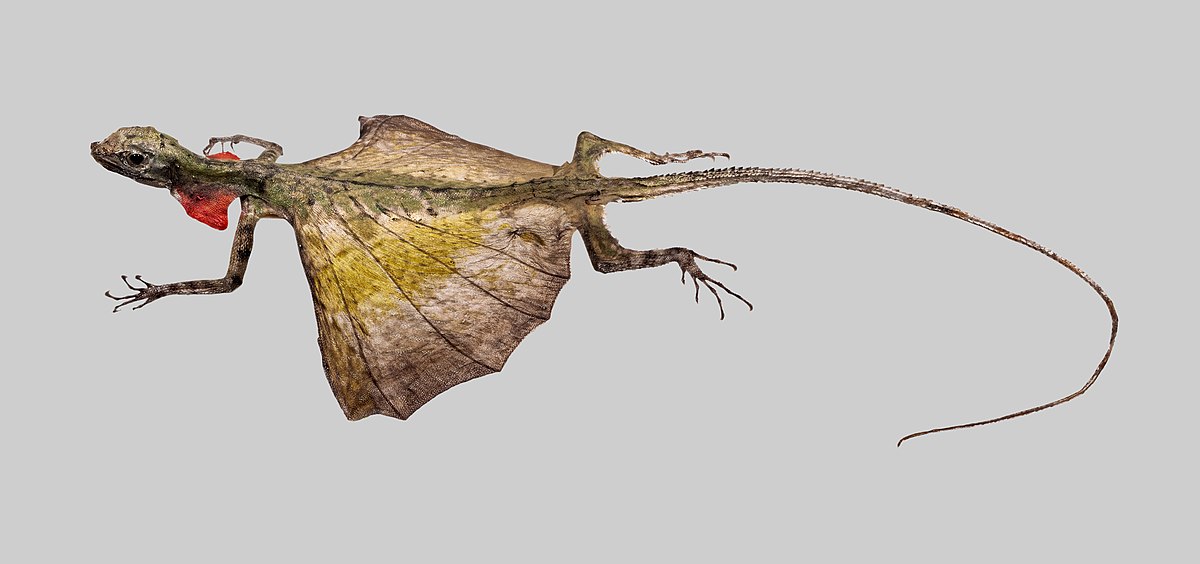DRACO VOLANS — The Dragon That Took to the Trees

DRACO VOLANS — The Dragon That Took to the Trees
In the realm of fantasy, dragons soar through the skies, breathing fire and inspiring legends. But in the dense, emerald canopies of Southeast Asia, a tiny creature brings that fantasy to life — no fire-breathing, no colossal wings, yet every bit as magical. This is Draco volans, the “Flying Dragon,” a real-life reptile whose unique anatomy allows it to glide gracefully from tree to tree, a living echo of myth and legend.
At first glance, the Draco volans might look like an ordinary small lizard, no more than 20–24 centimeters (8–9 inches) long from snout to tail. But spend a moment watching it, and you’ll witness one of nature’s most spectacular illusions — a sudden unfurling of delicate, wing-like membranes, painted with vivid patterns of orange, yellow, or blue. In an instant, it transforms from humble reptile to airborne marvel, gliding effortlessly through the forest.
A Miniature Dragon in the Flesh
The name Draco volans translates to “flying dragon” in Latin — a name it earns every day. Its most remarkable feature is the set of elongated ribs that extend outward from its body, supporting folds of skin called patagia. When spread, these patagia form a pair of “wings” that allow the lizard to glide distances of up to 60 meters (nearly 200 feet) in a single leap.
This flight is not powered — there’s no flapping involved — but rather a controlled glide, using gravity and aerodynamics to travel from one perch to another. In the treetop world where the Draco lives, this is a superpower. It means it can escape predators, chase prey, and find mates without ever needing to descend to the dangerous forest floor.
The Art of the Glide
Gliding is a high-stakes business. The Draco’s launch begins with a daring leap from a tree trunk or branch. As it pushes off, the lizard snaps open its patagia like a parachute, instantly catching the air. Its long tail, acting like a rudder, helps steer its path, while tiny movements of the “wings” fine-tune its direction.
The glide is silent. In the thick, humid forests of the Philippines, Malaysia, Indonesia, and southern Thailand, you might not even notice one passing overhead. Only a flash of color — perhaps bright yellow edged in black — betrays the dragon’s presence before it vanishes into the foliage.
Researchers studying Draco species have discovered that these glides are remarkably precise. The lizard can land almost exactly where it intends, clinging to a target tree trunk without bouncing off or overshooting. For an animal weighing just a few grams, wind conditions, branch density, and even the angle of sunlight all play a role in a successful landing.
A Cloak of Colors
One of the most enchanting aspects of Draco volans is the diversity of its wing colors and patterns. These aren’t random — each species within the Draco genus has distinct markings that can signal identity and health to potential mates.
Some males display brilliant oranges and yellows, while others boast shades of turquoise or green that blend seamlessly with the canopy. The underside of the patagia is often patterned in a way that makes the lizard nearly invisible when gliding from below — a form of natural camouflage against predators like birds of prey.
When resting, the wings fold neatly against the body, and the elongated ribs tuck back in, making the Draco look like an ordinary, slender lizard clinging to the bark. But when startled or in pursuit of a mate, the transformation from lizard to dragon happens in a heartbeat.
The Romance of the Flying Dragon
In the life of a Draco volans, love is also airborne. Mating rituals often involve aerial displays where males launch themselves into the air, flashing their most vibrant colors. They also extend a bright, fan-shaped throat flap called a dewlap, which serves as a visual signal to attract females and ward off rival males.
Courtship is not a drawn-out affair. In the high-stakes treetop environment, opportunities can be fleeting, and speed is essential. Once a pair mates, the female descends to the forest floor — one of the few times in her life she leaves the safety of the canopy. There, she digs a small hole in the soil with her snout, lays two to five eggs, covers them carefully, and returns to the trees.
From then on, the young are on their own. When they hatch, the miniature dragons instinctively climb toward the light filtering through the canopy, beginning their lives in the aerial highways above.
Life Among the Trees
Draco volans is a master of vertical living. Its long limbs and sharp claws are perfect for gripping rough bark, and its gliding ability means it can traverse vast territories without touching the ground. This not only saves energy but also reduces the risk of predation from snakes, monitor lizards, and mammals lurking below.
Its diet consists mostly of ants and termites, which it gathers by darting along branches and probing into crevices. Unlike some lizards that wait in ambush, the Draco is an active forager, constantly on the move, scanning for movement with keen eyes.
The forest canopy offers plenty of food but also plenty of competition. Other gliding animals, like flying squirrels and colugos, share the same airspace. But the Draco’s small size and quick bursts of movement allow it to weave through branches others can’t navigate.
A Living Link to Prehistoric Times
When people first see a Draco volans in action, many can’t help but imagine a connection to the dragons of legend or even to the flying reptiles of the Mesozoic era, like pterosaurs. While they aren’t direct descendants of those prehistoric fliers, Draco lizards are an example of convergent evolution — nature’s tendency to find similar solutions to similar problems.
Just as pterosaurs, bats, and birds evolved wings to navigate the air, the Draco evolved its rib-supported membranes to master gliding. Fossil evidence shows that other reptiles in Earth’s deep past had similar adaptations, making Draco volans a modern echo of those ancient creatures.
Myths, Legends, and Local Lore
In the rural villages of Southeast Asia, stories about small “dragons” flitting through the treetops have been told for generations. Children in some regions grow up calling them “tree dragons,” while in others, they’re considered good luck to spot.
While Draco volans can’t breathe fire or guard treasure, its beauty and mystery have given rise to tales that blur the line between fact and folklore. Some local beliefs suggest that the lizards are messengers of the forest spirits, ensuring balance in the ecosystem.
A Marvel of Adaptation
Gliding has obvious survival advantages, but for the Draco, it’s more than just escape and courtship — it’s efficiency. Moving between trees without climbing down and back up again saves enormous amounts of time and energy. This is especially crucial in the dense forests where trees can be dozens of meters apart at their bases but close together at the crown.
The elongated ribs that support the wings are incredibly lightweight yet strong, allowing repeated use without fatigue. The skin of the patagia is thin and flexible, folding neatly when not in use, so it doesn’t interfere with climbing or resting.
Threats and Conservation
Despite its apparent abundance in certain areas, Draco volans faces growing challenges. Deforestation, logging, and urban expansion are fragmenting the forests it depends on. Since the lizard rarely comes to the ground, clear-cutting an area can effectively destroy its ability to move between feeding and breeding sites.
While it is not currently listed as endangered, localized declines have been observed in regions where old-growth forests are disappearing. Protecting these habitats is crucial — not just for the flying dragon, but for countless other species that share the treetop world.
In Popular Culture and Science
Wildlife documentaries often highlight Draco volans as one of nature’s most enchanting spectacles. Slow-motion footage of a glide captures the elegance of its aerial dance, the sunlight filtering through translucent wings as it sails from branch to branch.
In the realm of fantasy literature and art, the Draco often serves as inspiration for miniature dragon depictions — proof that reality can be stranger, and sometimes more beautiful, than fiction.
Scientists continue to study its flight mechanics, hoping to understand not only how the lizard controls its glide but also how similar adaptations might have evolved in other animals. Its specialized movement has even inspired concepts in robotics and micro-drone design.
A Day in the Life of a Flying Dragon
Morning light seeps into the canopy, and a Draco volans stirs on the rough bark of a towering dipterocarp tree. Ants begin their busy march along a branch, and with a quick flick of its head, the lizard begins to hunt. A sudden movement from a nearby trunk catches its eye — another Draco, possibly a rival male.
In an instant, it launches. Wings snap open, colors flash, and it glides in a perfect arc toward the intruder’s tree. Landing with precision, it flares its dewlap, warning the other to back away. The rival retreats, and the victorious dragon continues its patrol, moving seamlessly between the trees, ruler of its leafy domain.
As the day ends, the Draco tucks its wings and settles into a crevice, safe from nocturnal predators. Tomorrow will bring more flights, more hunts, and perhaps the start of a new courtship — all played out in the secret aerial highways of the tropical forest.
The Magic of the Real World
In a time when fantasy worlds dominate films, books, and games, it’s easy to forget that our planet is already home to creatures that seem born from myth. The Draco volans is one such marvel — proof that evolution can create wonders every bit as magical as those imagined by human storytellers.
It may be small, but when it spreads its wings and glides through shafts of golden sunlight, the flying dragon reminds us that the boundaries between reality and legend are sometimes no more than a flutter of skin and bone.











